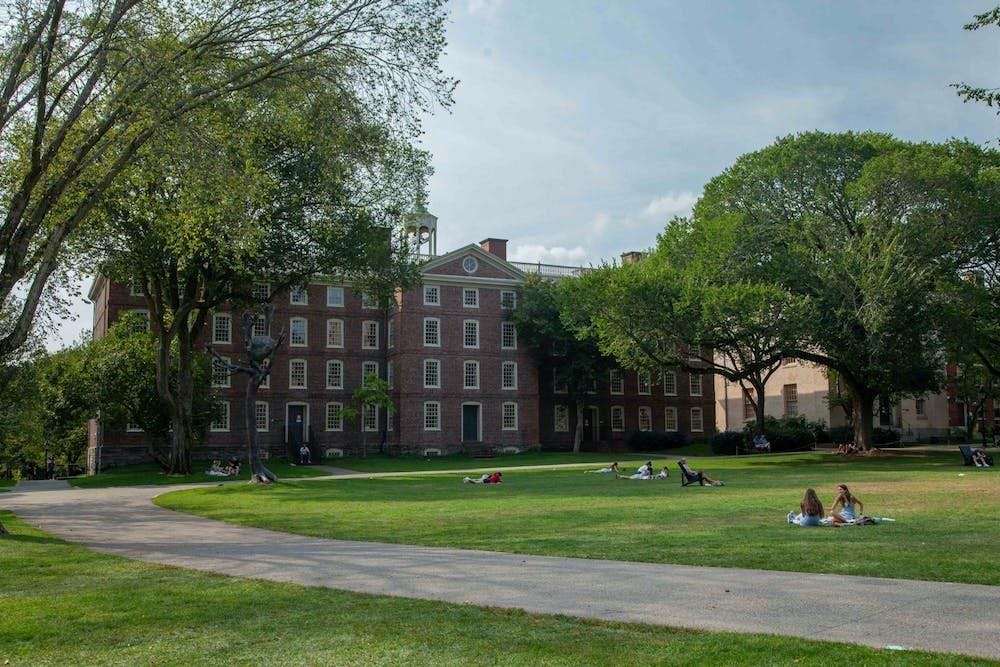Brown University will reinstate standardized testing requirements for most applicants to the College beginning with the class of 2029, according to University administrators.
The change comes after the Ad Hoc Committee on Admissions Policies, which has been discussing potential admissions policy modifications for the past six months, issued recommendations that President Christina Paxson P’19 P’MD’20 publicly adopted on Tuesday. Paxson also accepted the committee’s suggestion that Brown continue to offer an early decision round in its application cycle and said the University would consider community input and “a range of complex questions” as it evaluates preferences for legacy applicants.
Paxson announced the changes this morning in a community-wide message.
Along with her decisions, the committee released an executive summary of their report that includes their recommendations and rationale. The full report was not shared due to data privacy concerns.
The committee — comprising faculty, administrators and members of the Corporation, the University’s highest governing body — was formed in September in the wake of the Supreme Court’s decision to restrict race conscious admission policies.
Paxson charged the group with ensuring that the University was upholding its “commitments to academic excellence, equity, access and diversity” in its admission practices.
Throughout the summary, the committee continually revisited this bedrock principle, even with some contradicting sentiments.
The Herald sat down for an interview with Provost Francis Doyle, the co-chair of the committee, to discuss the group’s work and findings.
Reinstating standardized testing
Brown will become the third Ivy — after Dartmouth and Yale — to again require all first-year applicants to submit a standardized test score as part of their application, with the exception of those who are “unable to take the test” when “the International Baccalaureate or a national exam may be substituted.”
Transfer applicants, resumed undergraduate education applicants and prospective student veterans will still enjoy a test optional policy.
The committee cited student academic performance at Brown as a main reason for requiring the test, finding that higher test scores were correlated with higher grades at the University. Those who did not submit scores had comparable academic performance to those that submitted low scores. The findings aligned with the results of a study released earlier this year by John Friedman, the chair of Brown’s economics department and a member of the committee.
The summary adds that there are “unintended adverse outcomes of test-optional policies in the admissions process itself, potentially undermining the goal of increasing access.”
The committee acknowledged that those from well-resourced backgrounds tend to perform better on the exams, whether because of additional tutoring or other strategies. But Paxson accepted a committee suggestion to implement a “testing in context” campaign which aims to promote Brown’s policy of considering testing as one factor among many in a holistic review process.
The committee added that test scores interpreted in the context of an applicant’s background may actually benefit underrepresented students who admission officers deem to have academic potential at Brown.
“The committee was concerned that some students from less advantaged backgrounds are choosing not to submit scores under the test-optional policy, when doing so would actually increase their chances of being admitted,” the report said.
Admission officers will often compare applicants’ individual standardized test scores to overall test performance at that applicant’s high school in order to contextualize their academic performance. Doyle said that high schools often communicate this overall test performance to the Office of Admission or report it publicly.
This decision ends the test-optional policy that Brown has practiced since the 2020-21 application cycle.
40% of applicants to Brown chose not to submit test scores during that period, according to the summary. But that proportion decreases for those enrolled: only 24% of students did not submit a score in the 2022-23 application cycle, according to a Herald poll of enrolled first-year students.
Preferences for familial ties to the University will stay, for now
The committee did not reach a consensus in evaluating whether the University should end its preferences for applicants who are children of alumni or Brown staff members.
Instead, they have deferred any decisions until administrators can ask “members of the community — including faculty, staff, alumni and students — to provide input on Brown’s current practice of preferences for applicants with family connections,” according to the summary.
Doyle said the committee has not determined what the outreach plan would be and that the committee will “be looking for guidance from the President on her next steps.”
But when asked how Paxson plans to conduct this outreach, Senior Vice President for Communications Cass Cliatt wrote in an email to The Herald that “we have not predetermined an approach.”
Neither Doyle nor Paxson detailed concrete steps for community engagement.
Conventional wisdom holds that when children attend the same college as their parents, the family is more likely to donate to the institution — though there is little research to back that claim. In weighing the advantages of legacy admissions, Doyle said that effects to the donor base were a “factor” in the committee’s discussions.
He added that “students whose parents attended Brown tend to be exceptionally well-qualified, with academic records that are stronger than that of average matriculants.”
The committee also cited the tendency of legacy students to enroll at higher rates once admitted, pointing to the “sense of community and loyalty among Brown graduates” that the policy fosters.
Committee members did address concerns of socioeconomic disparities, writing that “removing legacy preferences could lead to somewhat more diversity in the group of admitted students.”
In another study, Friedman found that legacy admissions is the “largest factor driving the overrepresentation of high-income students” at Ivy Plus colleges, The Herald previously reported.
If the University “were concerned primarily with socioeconomic diversity, it would make sense to eliminate this practice,” Paxson said in an interview with The Herald earlier this month.
Brown consistently ranks among the lowest of the Ivies in the percentage of students receiving financial aid. The University also ranks 230th of 286 schools — again the lowest in the Ivy League — for the share of students receiving Pell Grants, according to a New York Times analysis.
The committee also put the recommendation in the context of the affirmative action decision, writing that some members “stressed the importance of fairness to the more recent, and more diverse, graduates whose children might benefit” given that their parents enjoyed an affirmative action admissions policy.
Past Herald polls have found that the population of legacy students contains a higher proportion of white students compared to the general student body. Legacy students were also less likely to receive financial aid than their non-legacy counterparts
“The issue of admissions preferences raises complicated questions about equity and access, about merit and unearned advantage,” the report reads, adding that coming to a recommendation “requires further deliberation and reflection.”
Approximately 8% of the class of 2027 are legacy students and 1-2% of all students are children of staff members.
Early decision holds strong
After considering a non-restrictive, non-binding early action admission policy, the University decided to continue offering a binding early-decision policy, as eliminating it may “place Brown at a slight disadvantage in enrolling very highly qualified students who are subsequently admitted to other institutions through Regular Decision,” according to the committee.
High rates of yield — or the percentage of accepted students who ultimately enroll — are often regarded as advantageous for universities hoping to confirm the composition and size of their first-year class. Early decision provides institutions with this certainty by enrolling 100% of the admitted early cohort.
Those who are accepted under early decision are contractually obligated to attend Brown, raising concerns among some critics that forcing families from lower socioeconomic backgrounds to commit to one school would prevent them from comparing financial aid offers from others. The committee rebuffed these concerns for students applying to Brown, noting that applicants are given corresponding financial aid awards whether they apply in the regular or early decision cycles, and that online financial aid calculators “help students and families estimate the cost of attendance at Brown.”
They also emphasized Brown’s commitment to meeting 100% of demonstrated need and forthcoming need-blind admission for all first-year applicants.
Despite this, the committee acknowledged that there are demographic discrepancies in the early and regular decision applicant pools. Early applicants are less diverse in measures of race, ethnicity and socioeconomic status, and are less likely to be first-generation or low-income students. The Herald’s first year poll found similar trends among enrolled students.
When asked how they could create a diverse cohort of admitted applicants with a less diverse applicant pool, Doyle said that the size of the “application pool means that we can identify a strongly diverse cohort of highly qualified students in a way that's guided by our unwavering commitment to access and diversity.”
Using measures such as standardized test scores and academic performance at Brown, Doyle said that the committee found the early decision applicant pool to be stronger than those in the regular decision review round.
What comes next?
To make prospective applicants aware of these policies, Doyle said the University will undertake extensive communications efforts to educate students, their families and high school guidance counselors “about how we will use test scores in context and why it shouldn't be intimidating that an individual might, for example, have a score that falls below the median.”
“Our admissions team is fully committed to that,” he said.
The committee completed their work using a data-driven approach that included outside input from student leaders and Associate Provost for Enrollment and Dean of Undergraduate Admission Logan Powell, according to Doyle.
While the questions of preference for children of alumni and staff members remained unanswered, Paxson wrote in a letter to the community that further discussion “will help inform an ultimate decision” without providing ways for stakeholders to provide this input.
She also invited students to attend a March 20 Brown University Community Council meeting to discuss decisions surrounding the committee’s work.
The new testing requirement “may take some convincing for stakeholders,” Doyle said, adding that he hoped to educate them on the “testing in context” philosophy.
Doing so “will be harder work for the admissions committee, and they understand that,” Doyle said, but added that the requirement will allow admission officers to “gain access to another instrument in the toolkit that they can use to make this holistic evaluation.”

Owen Dahlkamp is the managing editor of newsroom on The Herald's 135th Editorial Board, overseeing the paper's news operations. Hailing from San Diego, CA, he is concentrating in Political Science and Cognitive Neuroscience with an interest in data analytics. In his free time, you can find him making spreadsheets at Coffee Exchange.





